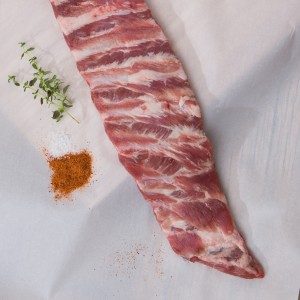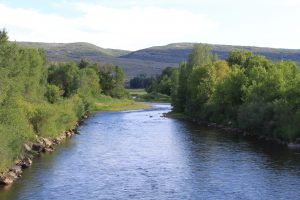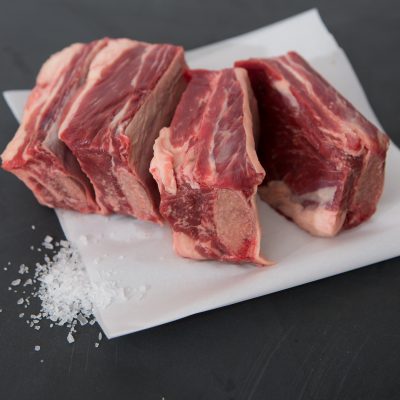As people living a Paleo lifestyle, we all know how great meat is. However, there’s so much more to meat than just buying and cooking it. Really understanding what aged meat is and how to age meat is a great skill to know because it helps to really bring out the flavor of the meat and gives it a better quality. Here is another very interesting interview I had with Rachel from 5280 Land and Cattle Co. on the science and magic of aging meat!
5280 Land and Cattle Co. is a Colorado based company that can provide your family with quality, sustainable meats at an affordable price. Their meat is always treated humanely without the use of hormones or antibiotics, and are allowed to roam free in their natural habitat.
In case you missed it, in Part 1 we learned tons of valuable information about the basics of ranching that we, as consumers, really should know about. In Part 2, we found out how to safely choose our meats, and WHY, and in Part 3, we learned all about what grain-finished really means. So, here’s Part 4 – let’s learn how to age meat!
- We have all heard of aged beef and some more high scale restaurants even like to showcase their aging room. But what is aging?
Aging is the process where after the beef is butchered and cleaned, its carcass is hung, in either whole or half parts, in a temperature-controlled climate where naturally occurring enzymes begin to break down the fat content and connective fibers in the meat. Also, at this time water evaporates from the meat as well. This process helps tenderize and flavor the meat. This process is best when it comes to cuts that have more marbling, such as a porterhouse, T-bone, and NY strip.
- So why would someone age meat? What does it do to the meat?
Aging beef adds more time into the processing, so that means more labor and more cost involved in the cuts. This is why typically you will find aged beef in nice steakhouses or restaurants or specialty meat markets. Aging tenderizes the beef and also concentrates the flavoring.

- I’m sure many are familiar with aged beef. What other meats are commonly aged? Can pork be aged for example?
Pork can be aged, especially hams, but we are not really familiar with whether or not there really is an added taste benefit to dry aging pork or lamb. We do know it’s more common with beef and wild game and we do not age our hams. The customer has a choice between a cured & smoked ham and a fresh ham, which is neither smoked nor cured. A lot of pork gets smoked, whereas beef can be smoked as well, but for example, you wouldn’t necessarily buy a smoked brisket and then reheat it at home. You would find more smoked hams or bacon common in pork.
- Are their different ways to age meat?
Yes, there is dry aging, wet-aging and smoking.
- I hear wet aging is more popular in the U.S. What exactly is wet aging and why is it the favored choice?
Wet-aging is an aging process that is popular here because it reduces the time needed for the beef to age. The beef is vacuum sealed in plastic and retains all its moisture, so there is less weight loss. The beef is in contact with its blood which tends to make the meat a little more bitter or sour, but this is the most common form of aging found in most grocery stores, likely due to the cost savings.
- Can you explain a little about the process of dry aging and what this does to the flavor and texture of meats?
Our beef hangs for 2 weeks. Though most commonly, you may hear that beef hangs from 21-28 or more days. The reason being is that our beef has less fat/marbling in those prime cuts that you really are trying to tenderize by aging when compared to its grain-finished counterparts. Less fat content equivalates into less time it takes the enzymes to break down the fat and connective tissue, which ultimately is what gives you that tender steak you want. By aging you are also condensing/intensifying the flavor.
- What about smoking? What is this and what does it do to the taste of a meat?
Smoking meat is the process of preserving meats where the meat absorbs the smoke which acts as a preservative. Different types of wood commonly used to smoke meats include: hickory, mesquite, apple and cherry. The temperatures at which meats are smoked also have an effect on the flavor. There is hot smoking where the temperature ranges from about 120-180F degrees, whereas cold smoking ranges from 70-90F degrees. Most BBQ meats you assimilate as smoked—such as brisket, ribs, pork shoulder, etc. We would probably suggest talking to someone BBQ savvy for more detailed information. This is the scope of what we know about BBQ and smoking; other than that it acts as a more natural preservative, tenderizes the meat and it tastes good! There is a science behind smoking meats and any good BBQ connoisseur probably has a few strategies and secrets of how they smoke their meats.

- I have read ingredients for meat that is treated, such as sausages, and some interesting ingredients seem to come up. Is there sugar in either of these processes and what is the sugar used for?
The curing of meats, such as hams or even in sausages, sometimes contain nitrates, dextrose or sugars like brown sugar (added taste), and salt. These ingredients are used to preserve and flavor the meats. Curing draws out the moisture in the meats and the nitrates help add flavor and coloration as well as prohibit the growth of bacteria. After the meats are cured, they are then smoked. Some people do not like the idea of nitrates because they are synthetic preservatives. We have addressed this with our processor and they do process with nitrates in their cured meats to help ensure food safety. To customers who do not want nitrates in their meat, ask for fresh. We also offer fresh ground pork, fresh sliced side (basically uncured bacon) and fresh hams. There are ways you can do your own curing at home to get the flavoring that you like, but from what we have discussed with our processor, it’s a safety issue for them.
- What about the health effects of smoking and aging? Do either of these processes add or detract from the health benefits of a meat and, if so, how?
To be honest, we really don’t know! Just off the top of our heads we feel like there are a lot of variables here. We would imagine smoked meats that are uncured do not contain the synthetic nitrates and would then be a “healthier” choice if you’re concerned with nitrates. Another factor would likely be what seasonings you are prepping your meat with—they might have sugar, which is really in the hands of the preparer. From all we know about dry aging, it’s not a matter of healthy or not, it is primarily done to improve the taste and tenderize the meat.
- Ok, a fun question I’m sure all of us are wondering on this topic: how is bacon made?
Yay! Meat candy! Bacon is just so delicious. Bacon comes from the pork belly and is also referred to as a “side”. First, the side is seasoned with spices and water and then it goes into a tumbler for 24 hours. It is then taken from the tumbler and hung up, smoked and cooked in a smokehouse. Then it is chilled and sliced and packaged. Our processor has their own proprietary blends of seasonings not only for the bacon but for their sausages as well.

- Is there anything final you want to say or add about this?
We learn more and more about curing, dry aging, smoking etc. as we spend time in the meat business. It is a true science and some people are very secretive about their practices when it comes to handling meats, especially BBQ and smoking. Since we do not handle the processing and cutting of our meats, this is probably the area that I personally feel the least knowledgeable on. Ty knows and understands more, as he has grown up in ranching and spent a lot of his youth in 4-H, which included learning the how-to and competing in judging meat. We try to learn more everyday about the why and how of meat preparation and preservation.
Where we are now at is 6,555 feet in elevation. The town of Meeker itself is a bit lower than that around 6,200 feet. We are in the northwest corner of Colorado and about 4-4.5 hours from Denver. We are close to the Wyoming and Utah border, within an hour’s drive.
We have shorter summers than Denver. it doesn’t really warm up here (by warm I mean 70-75 degrees) until June. By September it starts to cool off with snowflakes flying by mid-October. The winters are VERY cold. We will have a few weeks every winter where it does not get above zero.
A lot of people ask what we do with the animals. Well, the pigs have heat lamps and we add a lot of straw so they can nestle. You’d be surprised how much heat pigs give off! They snuggle together and stay warm. A little cold is ok though, because you want them to grow a layer of fat, not only will it keep them warmer, but the hope is that they continue to gain weight. That is hard to do sometimes in the winter even with the steers. They eat just to stay warm, not to gain. What we do is make sure no matter what season, that they have free choice of food and water so they can hopefully continue to gain.
By late March, spring starts to show small signs of life! It’s a welcome sight, but still, it is cold here until June. Our local economy really depends on the energy companies and outdoor activities like hunting, fishing, ATV, snowmobiling, etc. We are not a ski town. Steamboat Springs is about an hour and a half from here and Sunlight in Glenwood Springs is also close – about the same distance. Our population is about 2500 or less since a lot of the energy companies are moving out of Colorado to the Dakotas and Wyoming. In the summer, like now until October, it is so beautiful. It doesn’t get much above 90 and the landscape is so beautiful and green when everyone is haying and we’ve been lucky enough to have a decent, wet spring. The White River (the big river that runs through Meeker) is perfect for fishing in the summer and it’s a great time to visit.

If you have any questions or suggestions, email me at Info (at) TinaTurbin (dot) com



